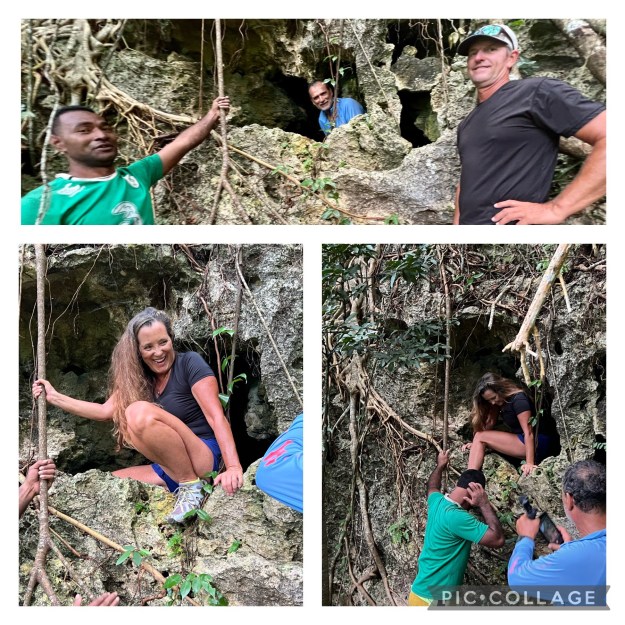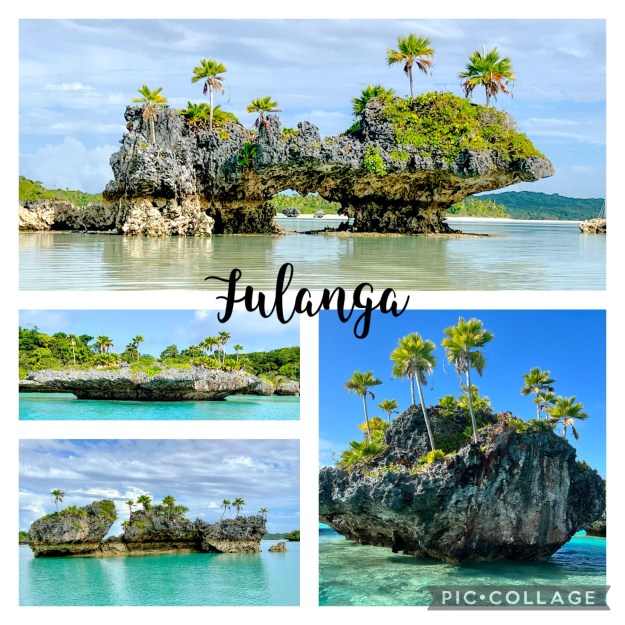Matt and I make another overnight sail from Bavatu to Fulanga (which is also known as Fulanga and Vulaga / Vulanga). It is only a 100nm sail but we have to time the exit from Bavatu pass and the entry to the Fulanga pass during slack tide which makes it an overnight.
The sail was relatively easy as it started with 17-18kts of wind from the NE giving us a tremendous boat speed of 8-9kts. We kept enjoying the fast speeds as we knew we would lose the wind later in the day. About 6 hours later the wind dropped to 8-9kts and then it dropped even lower to 5-6kts. We did our best to squeak miles out under sail before it got to slow forcing us to turn an engine on. We arrived just as planned at 0700 which was perfect timing for the pass. We were traveling with 3 other boats and we all entered with no problems.
The Village
After securing a prime spot for anchoring, we all headed into the village to do our sevusevu (a requirement). We all brought out sulu (which is a parero / sarong) and our bundle of kava (which the locals make into a drink) and dinghied 20-minutes across the lagoon to the landing. We tied the dinghy up, removed our hats, put on our sulu and followed the path to the village (a 20-25-minute walk). Along the way we met many villagers who each stopped, shook our hand and introduced themselves. So friendly!
We do a short version of Sevusevu because the men are holding a village meeting. They offer us kava to drink, but we declined as it was a huge crowd and huge bowl of kava and we did not want to try it for the first time with an audience.

After we present our gifts of kava and $50F (for community repairs and support), we are introduced to our host family. Our host family, Nico and Lucy offer us ridiculously hot tea and cakes and tell us about the village.

There are two villages within walking distance of each other. Each village has an “Artisan Market.” Evidently all the men are wood carvers and they give it to the market to sell to help provide for the village. I purchased a pretty floral bowl, a small carved turtle and a hammerhead tooth (for Jake Martin).

Cave of Bones
There are many things to enjoy in Fulanga, but a must see is the “Cave of Bones.” We ask our host family if we can go see this cave and visit one of the lookout points. They arrange for a guide (as they are older and cannot take us themselves). Our guide is the host family for one of our cruising friends so we all go together. Balé is very sweet and takes his time walking us up the rocky terrain. It is a short, but super steep hike up the mountain. We walked 4.3 miles, went up about 23 floors and managed about 12k steps.
The cave opening is a wee bit small that you have to climb into. It is surrounded by lava rock which tends to snag your clothing and skin.

Inside the cave are lots of skulls, femurs, and other miscellaneous bones. Matt decided one skull looked better with his hat and glasses.

It was kind of cool yet super creepy to hold the skulls in your hand. They seemed so very small to me.

Of course, you have to have a skull and cross bones image too.

Another short, steep hike up the hill to the look out and it was well worth the effort. One view overlooks the anchorage and the overlooks the two villages.

Here is our group of hikers, Matt and I and our friends on Rapture, Greg and Susan.

The Anchorage
Like many of the other Lao group islands, Fulanga has many towering rocks that jet out of the sea to the sky. They are covered with palm trees and bushes and completely break up the lagoon.

We find a beautiful spot to anchor away from the other boats, but close enough to our friends that we can dinghy over for dinner.

This sign made me laugh…it is located outside the medical clinic (read the last line)

Dinner on Anima
We met some new friend and old friends (whom we know from French Polynesia) and had dinner onboard Anima. It was “Rapture”, “Sea Jay”, and “Anima”. Manuel and Thomas prepared a traditional Portuguese meal with some fresh fish they caught!

We enjoy a Fijian celebration of “lovo” at the bay of Bavatu after hiking 271 steps! This blog occurred end of June. Our blog posts are 10-12 weeks after actual events occurred.
Like this:
Like Loading...


























